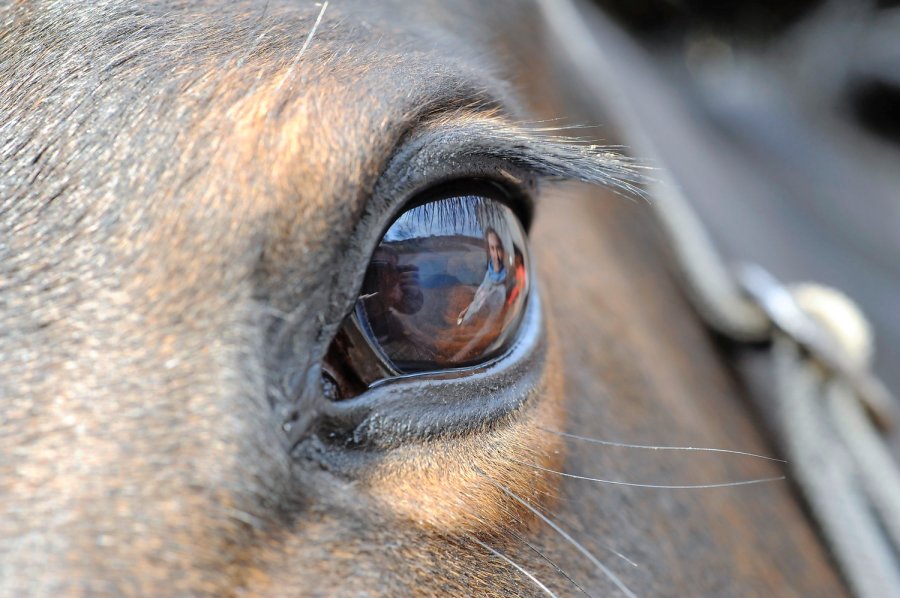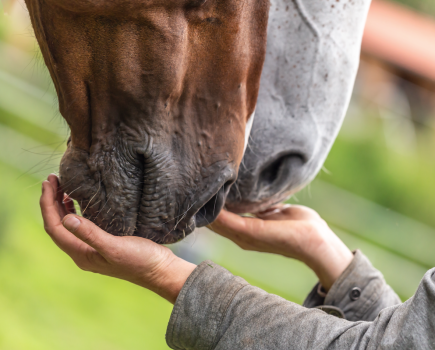When Karen Thomas discovered that her 16.2hh Clydesdale cross Hovis would need surgery, she was terrified by the prospect of him going under general anaesthetic.
“Hovis was 14 years old, weighed in at 755kg and had an incredibly low tolerance to sedatives. But I wanted to give him a chance,” says Karen. “We’d spent the year getting him sound after a serious leg injury and he’d not shown a single sign of vision issues. He hadn’t started spooking or shown any distress. But after a chance spot by my vet he was referred to one of the top equine eye specialists in the country. Hovis was carrying a massive cataract in his left eye and a similarly large one in his right. He’d been surviving on peripheral vision and trusting people around him to guide him.
“Soon after, Chris Dixon from Veterinary Vision came to look at Hovis. He showed me how little vision Hovis had, and how his left eye was deteriorating and supported my decision to operate. Chris and his team were incredible. They removed Hovis’ lens, the associated cataract and replaced it with an artificial lens. The operation was the longest few hours of my life. Now, six weeks after his operation, Hovis is a happy, healthy horse again – and he can definitely see!”
Cataracts explained
The inside of a horse’s eye is a complicated place, and cataracts can be tricky to spot. Every horse is at risk, as Chris Dixon from Veterinary Vision explains.
Cataracts is a condition found within the horse’s eye and can result in reduced vision. Horses both young and old can develop cataracts and it’s not confined to specific breeds. The condition may be congenital (present at birth), hereditary or, in some cases, the result of an inflammation, infection or trauma.
Cataracts are opacities within the lens. If the condition is mild, then the cataract will form tiny dots over the horse’s central vision, making their sight cloudy. If the condition is severe, their vision may turn opaque and surgery will be needed. The horse could go blind if a severe cataract is left untreated, but equine cataract surgery isn’t something to be undertaken lightly because it requires general anaesthetic. It’s unknown how many horses are affected by cataracts because mild cases are rarely picked up, but the symptoms are becoming more frequently recognised.
Symptoms and diagnosis
Symptoms of cataracts usually develop over time but occasionally they progress rapidly. If the horse is worked regularly, you may notice they start to try, shy, stumble, drag their feet during work or generally hesitate. This is because they’re struggling to see obstacles. Horses with cataracts may follow light across the floor to look for shadows and if there is a cataract in one eye, they’re likely to tilt their head to one side to maximise sight.
To determine whether a horse has cataracts, a vet will dilate the eyes and examine them as part of a five-stage vetting. This includes looking at the horse in-hand, under saddle and after exercise. Often the vet will do this with a pen torch in a darkened stable. If a positive diagnosis is suspected, they’ll refer the horse to an eye specialist who will then decide whether surgery is required.
Treatment
Advanced cases of cataracts will need surgery, but any inflammation or infection in the eye will need to be dealt with before. Then, providing the owner has agreed, the horse will be scheduled for surgery and put under general anaesthetic.
Surgery starts with a small incision of 28mm, cut into the cornea. The cataract is subsequently removed and a plastic lens is inserted into the remaining lens capsule. This new plastic lens replaces the cataract and allows the horse to focus light into the back of the eye. The cornea is then closed using thin stitches that resemble human hair.
After surgery, the horse is given a mask to wear and will require box rest for several weeks. During recovery the eye will be sensitive but the mask will protect it. Eye drops will need to be applied regularly and medication may be administered through a special tube that was inserted during the operation.
The horse is kept under close observation for signs of complications and ongoing check-ups will be performed. Eventually the eye specialist will permit the horse to be walked in hand and slowly eased back into full work.
Prevention
Some cataracts are genetically or congenitally formed and are difficult to prevent, but sometimes they originate from an inflammation or infection.
Generally checking your horse’s eye area is good policy to help catch problems before they occur. Watch out for regular squinting, refusal to open an eye, weeping or headshy behaviour. If your horse has suffered trauma to the eye, call your vet for advice because quick action may save their sight. However, if cataracts have formed, you can’t prevent further development.
Meet the expert: Chris Dixon BVSC CERTVOPHTHAL MRCVS is an RCVS accredited advanced practitioner in veterinary ophthalmology.
Don’t miss the latest issue of Your Horse Magazine, jam-packed with training and veterinary advice, horse-care tips and the latest equestrian products available on shop shelves, on sale now.
Find out what’s inside the latest issue of Your Horse
Check out our Christmas subscription offer – the perfect gift for a horse lover!







